
Papillomas are called benign skin and mucous membranes. However, certain strains can cause tissue degeneration. That is why experts recommend timely removal of papillomas. This will help prevent the development of malignancies, including the development of cervical cancer in women.
Ingestion of human papillomavirus (HPV) causes papillomatous growths on the skin and mucous membranes that may not occur for a long time. With weakened immunity, tissue damage, chronic transport causes cell hyperplasia. HPV begins to multiply actively, resulting in papillomas or warts on the skin or genital warts (on the mucous membranes of the genitals).
Predictive factors
The following factors contribute to the active growth of papillomas:
- frequent changes of sexual partners, infection with sexually transmitted diseases;
- household contact with people who have warts, warts or papillomas;
- skin and mucous membrane damage;
- weakening of immunity.
80% of people who reach puberty have HPV inactive. The virus does not cause the growth of neoplasms for up to 6-8 months after contact with the virus carrier. The exceptions are genital warts and papillomas, which occur in the first weeks after intimate contact with an infected person.
Why remove papillomas
The papillomavirus poses a serious health risk. Strains with a high oncogenic risk are particularly dangerous: 16, 18, 30, 31-35, 56-59, 67-68. When papillomatous growths occur, a dermatologist or venereologist should be consulted. The doctor will perform an external test and order a PCR diagnosis that will determine the viral DNA and determine the degree of oncogenicity of the particular strain.
In addition, the specialist will select the most effective surgical methods. Only a doctor, having the results of the test, can tell you exactly how to remove papillomas with minimal health risk. It is not recommended to leave such tumors. When exposed to adverse factors, they can cause inflammation, bleeding, and benign or malignant tissue hyperplasia.
Important!It is necessary to remove papillomas in intimate places - this is where neoplasms of high oncogenic risk usually occur.
If papillomatous growths are found on the external genitalia (vulva, perineum, foreskin), it is necessary to consult a venereologist. In addition, it is worth maintaining doctor-prescribed tests aimed not only at determining the type of HPV, but also at detecting concomitant urogenital infections.
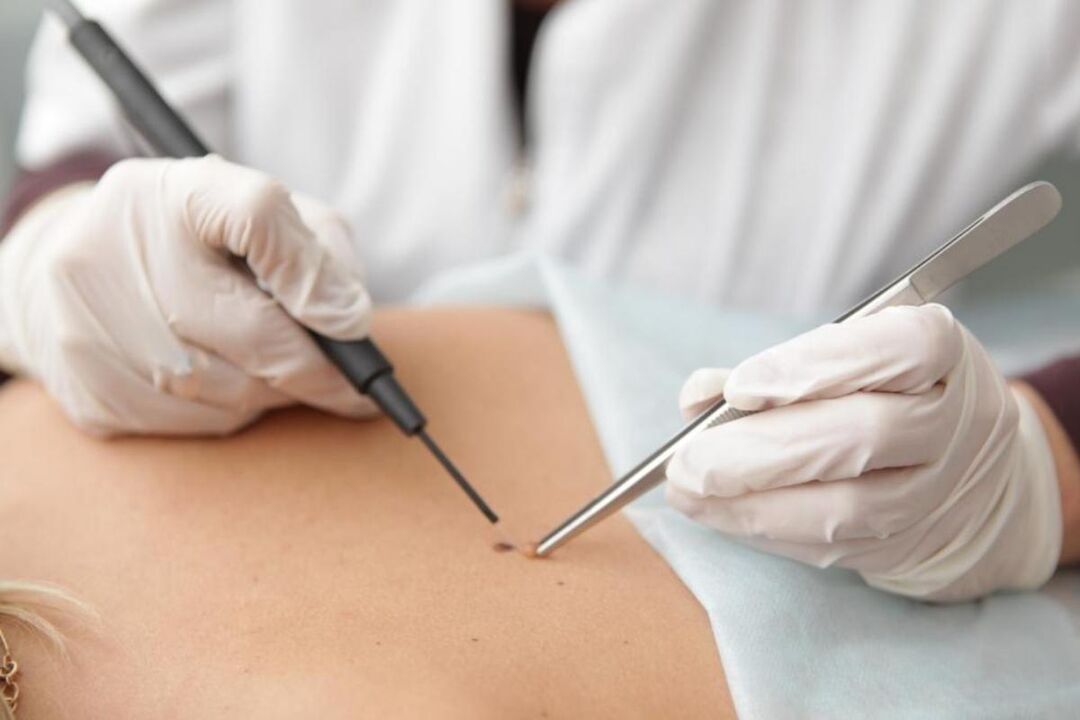
Surgical treatment of papillomas
The main methods of surgical treatment of papillomas:
- use of special local measures to remove papillomas at home;
- cryodestruction (removal of papillomas with liquid nitrogen);
- laser coagulation (laser papilloma removal);
- removal of radillary wave papillomas;
- cutting of derivatives with a scalpel.
Any of the methods listed can remove papillomas. A specialist will help you choose the right option based on the location of the neoplasm, the number of papillomatous growths, and diagnostic data. Before removing the papillomas, the doctor must make sure that there is no malignant process. In case of high oncogenic risk, experts choose the classic method of papilloma removal - removal of neoplasms with a scalpel.
The main indications for papilloma removal:
- desire to get rid of a cosmetic defect manifested by single or multiple papillomatous growths of the skin and mucous membranes;
- frequent lesions, bleeding and inflammation of the neoplasms under the armpits, on the neck, in the groin wrinkles, leading to an increased risk of tissue malignancies;
- detection of moderate to high oncogenic risk papillomas;
- the presence of people with malignancies among relatives;
- the location of papillomas is the genitals and internal genitals.
The ideal time to remove papillomas
Before removing papillomas from the body and face, the doctor warns the patient about possible complications, including the formation of age spots. The risk of pigmentation is higher in spring and summer. Many people wonder if papillomas can be removed in the summer. If the formations are in open areas of the body or on the face, it is better to postpone surgery for the cool season, when the likelihood of secondary infection and the formation of pigmentation is lower (UV activity decreases in the autumn-winter period).
Important!It is not enough to remove the neoplasm - it will not be possible to stop the growth of the papillomavirus. Surgical methods are necessarily combined with therapeutic ones.
It is not possible to get rid of HPV completely - a small amount of the virus will still remain in the body. However, in combination with antiviral drugs, surgical methods provide the highest treatment results.

Laser papilloma removal
Laser papilloma removal is a modern method of surgical treatment of HPV. Carbon dioxide laser systems are most commonly used by professionals. There are no scars or defects on the skin after the procedure. The high cost of laser papilloma removal is consistent with the effectiveness of the method. The final price depends on the size and number of violations. At one time, the doctor can destroy up to 5-20 medium-sized derivatives with a laser. After the examination and consultation, the specialist will tell you exactly how much it costs to remove the papillomas and provide detailed recommendations. In addition, antiviral treatment is mandatory. Medications are also selected by the attending physician.
With the help of a laser, papillomas can be removed from anywhere in the body, including the genitals. This method is bloodless and contactless. The laser has an anti-inflammatory effect on tissues, seals blood vessels, prevents bleeding. Papillomas usually occur on the hands (warts) and on the neck in the form of filamentous growths, which are easily damaged during hygiene procedures. Such tumors do not have a high oncogenic risk, but it is still better to get rid of them.
Features of laser papilloma removal
A dermatologist is consulted before the procedure. The doctor examines the skin and identifies possible contraindications:
- tissue damage;
- local inflammation of the skin and mucous membranes;
- pregnancy;
- exacerbation of any infectious processes;
- herpes.
Laser removal of papillomas uses semiconductor lasers, which evaporate viral neoplasms and at the same time coagulate blood vessels. When the growth of papilloma is destroyed, a protective crust (scab) forms on the skin. One week after removal, he gives up on his own. 2 months after the procedure, the skin tone is completely smoothed. The location of the papillomas will be no different from the adjacent tissues.
skin care
The scab formed by laser removal of the papilloma must be protected from sunlight, water and cosmetics. Forced peeling of the crust is prohibited - it can cause wound infection, large scars and prolong tissue healing time.
When the scab retreats, it is recommended to apply sunscreen to the skin before going outside. This will prevent the formation of age spots. It is not necessary to wear sunscreen during the winter months.

Nitrogen removal of papillomas
Nitrogen removal of papillomas involves freezing of neoplasms (cryodestruction). The method is effective for single papillomatous skin growths. A significant disadvantage of cryodestruction is the inability to control the depth of tissue freezing. Therefore, it is very important to responsibly choose a clinic where papillomas will need to be removed. The doctor must be licensed to perform surgery.
Extremely low temperatures inhibit metabolic processes in neoplasm cells and cause their death. A necrotic area forms at the site of the removed papilloma, which is gradually replaced by healthy tissue. Cryodestruction is available to most patients. The procedure is much cheaper than other methods (laser coagulation, removal of neoplasms by radio waves).
Papillomas can be removed both for aesthetic reasons and in specific indications. Of particular concern are neoplasms that enlarge, change hue and shape, become inflamed, and are injured during hygiene procedures.
Cryodestruction properties
Before removing papillomas with liquid nitrogen, the doctor carefully examines the skin, assesses the general state of health and identifies possible contraindications:
- acute infectious processes;
- decompensated stage of somatic diseases;
- exacerbation of skin diseases;
- herpes;
- tissue damage in the area of the neoplasm;
- pregnancy period.
Nitrogen removal of papillomas is performed without anesthesia. The cryodestructor applicator is held over the neoplasm for 1-2 minutes. The skin becomes white and cold, and temporarily loses sensitivity. There is a slight tingling sensation during the procedure, a burning sensation may occur. Within a few hours after the procedure, the skin is swollen and red, and within 24 hours after cryodestruction, vesicular elements with serous fluid appear on the treated area.
Tissue cryonecrosis lasts up to a month, after which the dead neoplasm sites are discarded and replaced by invisible spots that disappear completely 3-5 months after application of liquid nitrogen.
skin care
In the first weeks after removal of papillomas by cryodestruction, it is recommended to protect the skin from moisture, sunlight and other adverse factors. If severe inflammation occurs, you should consult a doctor. Tissues usually heal on their own, but at low epithelialization rates, your doctor may recommend cosmetics that speed up the regeneration of damaged skin.
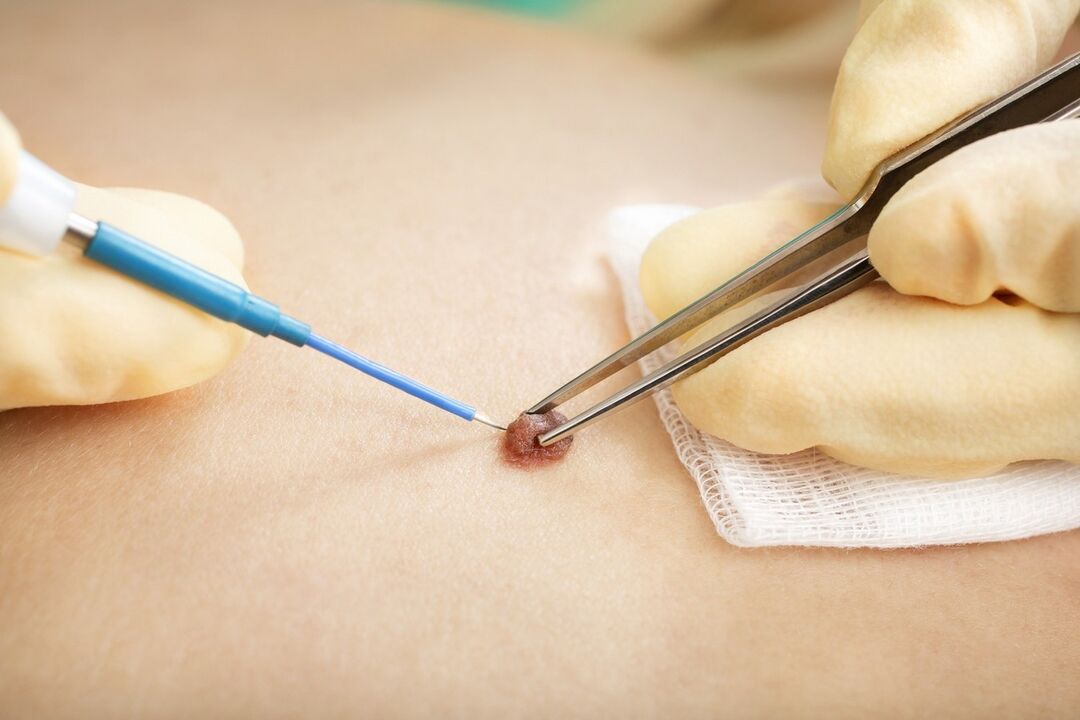
Removal of papillomas by electrocoagulation
Electrocoagulation of papillomas involves the removal of skin growths by an electric current. The method is quite traumatic, but it has an affordable price. High frequency current coagulates neoplasmic proteins and causes tissue rejection.
Features of the procedure
Prior to electrocoagulation, the specialist may prescribe dermatoscopy, PCR, and other laboratory diagnostic methods. The doctor examines and identifies possible contraindications:
- exacerbation of herpes infection and any inflammatory processes;
- pregnancy;
- suspicion of the malignant nature of papillomas;
- hypersensitivity of the skin, allergic reaction to electric current;
- exacerbation of severe somatic diseases, especially the decompensation stage.
skin care
Electrocoagulation of papillomas does not require any complicated skin care. Factors that can cause inflammation and secondary infections must be avoided. The scab formed in the first weeks is discarded, after which the skin is completely cleansed and replaced with new cells. Direct sunlight must be avoided during this period. Your doctor may recommend that you treat the wound with a weak solution of potassium permanganate.
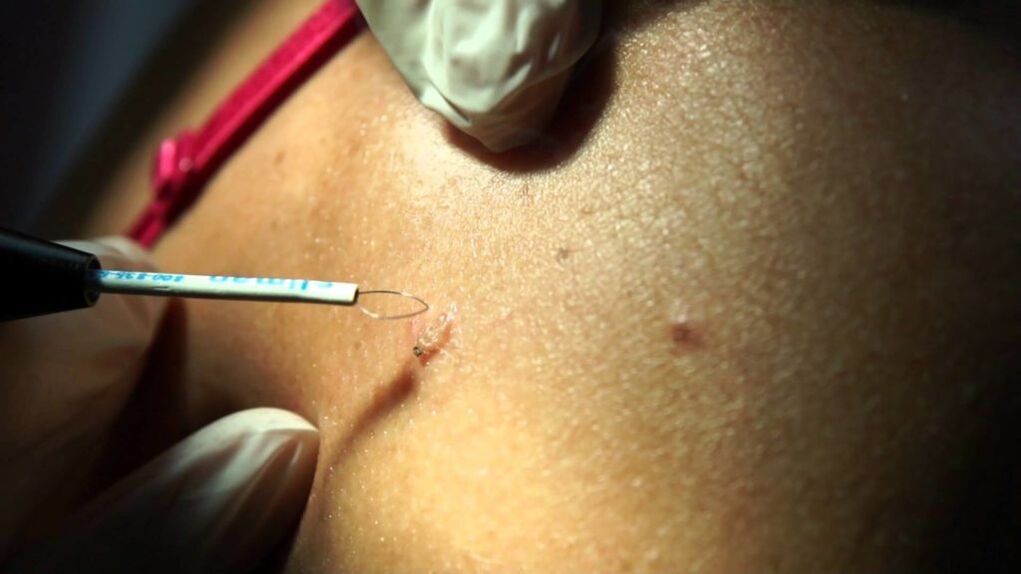
Removal of papillomas by radio waves
Removal of papillomas by radio waves accompanies atraumatic incision and clotting of neoplasmic tissues. Radio waves provide a very precise effect, while not damaging healthy tissues and preventing HPV from spreading through the bloodstream. Radiosurgical devices used in modern clinics stand out for their safety and reduce the risk of any complications.
Features of the procedure
Preliminary diagnosis allows to determine the amount of virus in the body, the type of HPV and the degree of oncogenic risk. When choosing a method of treatment, the doctor takes into account the general state of health and identifies possible contraindications:
- pregnancy, menstruation;
- exacerbation of any infectious and inflammatory processes and somatic diseases;
- the presence of malignancies;
- exacerbation of herpes infection;
- skin damage at the site of exposure to radio waves.
High frequency energy cuts the skin, clots blood vessels and papilloma tissues. In this case, the electrode does not have direct contact with the tissues, thus avoiding painful sensations and muscle spasms. In contrast to the electrocoagulation method, the use of radio waves can shorten the thermal exposure time and reduce the necrosis of the treated areas.
skin care
The procedure is performed under local anesthesia. Removal of papillomas takes only 15-30 minutes. Instead of treated tissue sites, dot scabs remain, which are automatically rejected within a week without leaving rough scars or other defects. During the recovery period, it is recommended to limit contact with water and ultraviolet rays, you should not use cosmetics and household chemicals.
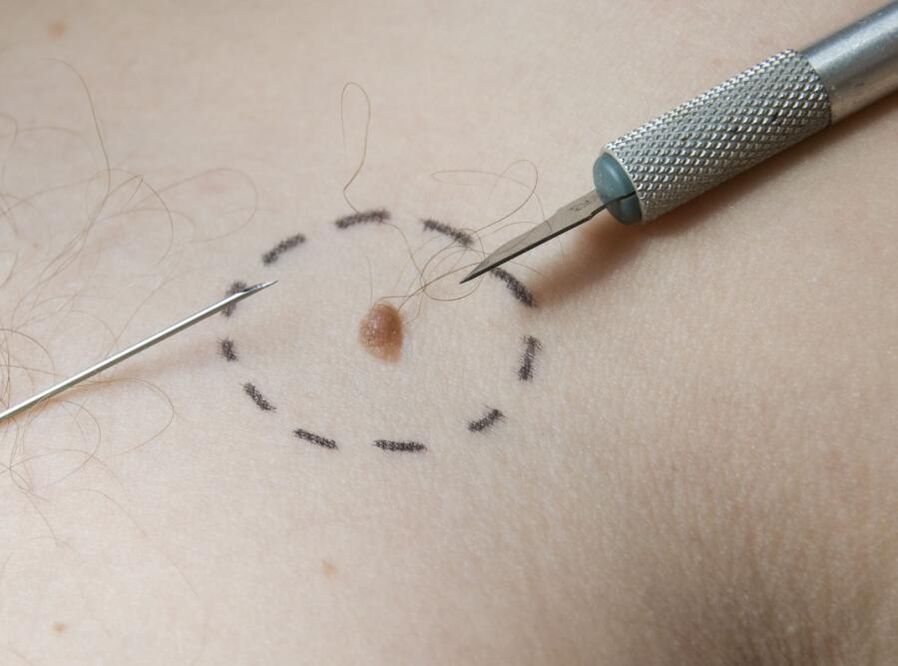
Surgical removal with a scalpel
Removal of papillomas with a scalpel is used quite rarely during classical surgery, mainly when malignant signs of the neoplasm are detected. In this case, the surgeon removes the papillomatous growths, capturing healthy skin.
The method is traumatic, leaving scars and stains. If desired, they can be removed by laser and other cosmetic procedures, including acid peels. Specialists try not to use surgical removal of papillomas in open areas of the body and on the face.
Papilloma removal products
Medicines to remove papillomas and warts work in the same way: they contain substances that kill neoplastic cells and form a small scab in the future. It is recommended to use modern type medications that have a lower risk of complications in the form of secondary infection, acute inflammatory reactions, blemishes and scars. Cryopreparations can also be used that can replace standard cryodestruction.
Removing papillomas at home is quite dangerous, especially in the case of large tumors. It is better to consult specialists who will select the optimal treatment options, including antiviral treatment, which prevents the recurrence of human papillomavirus infection in the future. A specialist will tell you exactly how to remove papillomas at home and whether it is worth doing. Preparations for topical application to skin growths are used for individual small tumors.
As it is not always possible to remove papillomas with the help of medicinal products alone, it is still recommended to consult a dermatologist. For small tumors, your doctor may recommend tested medications that will kill the papillomatous growths. In addition, the use of antiviral drugs is recommended. An integrated approach increases the efficiency of the entire treatment process. Antiviral drugs can only be discontinued if the papillomas are solitary and do not tend to multiply and grow malignantly.
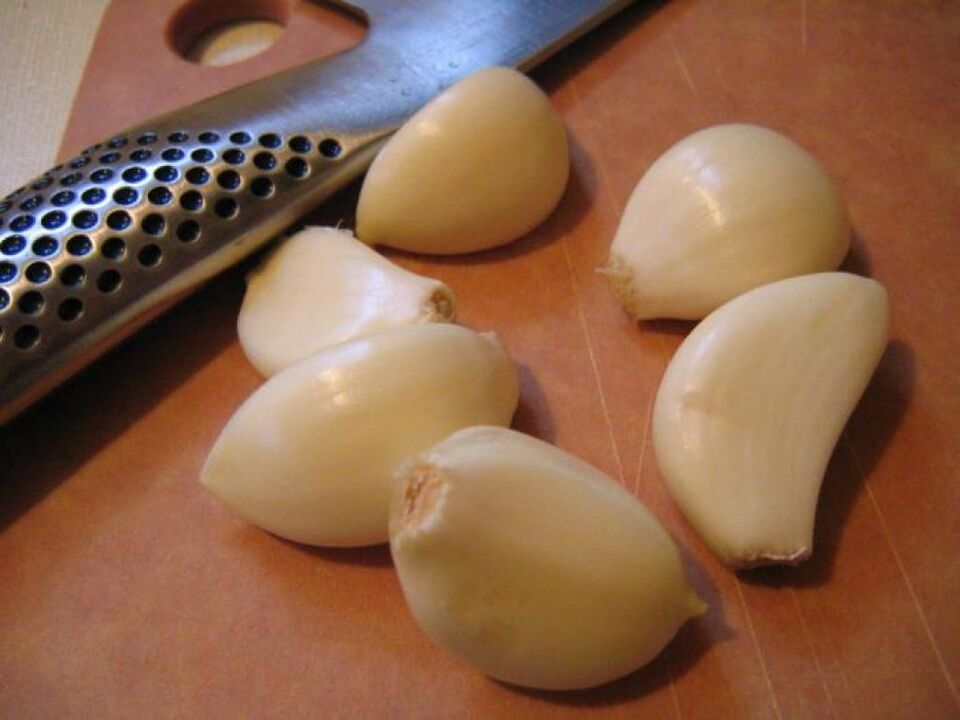
Removal of papillomas by folk methods
Removal of papillomas by folk remedies at home is popular. The public does not take the papilloma virus seriously enough. Many are not even aware that papillomas can become malignant. Since it is almost impossible to remove papillomas at home without health risks, it is first recommended to consult a dermatologist. Using modern diagnostic techniques, the physician will be able to assess the nature of the neoplasm and select an effective treatment regimen.
Simple Papilloma Removal Techniques At Home
You can remove papillomas at home using the following tools:
- celandine juice;
- garlic;
- walnut juice;
- Salicylic acid.
Important!The methods listed destroy skin growths. The use of such funds on the mucosa is strictly prohibited due to the high risk of acute inflammatory reactions and chemical burns.
Firewood juice is most commonly used to remove papillomas. Damaged skin areas are treated with this product several times a day. In this case, celandine should not be applied to healthy tissues. To prevent burns, it is recommended to treat intact skin with vegetable oil or zinc ointment before using the juice.
Garlic has a disinfectant effect, long-term use helps to remove warts and papillomas. However, this method is not suitable for people with sensitive skin. Garlic often causes inflammatory reactions, a burning sensation and redness.
Salicylic acid contributes to the destruction of skin growth caused by the active multiplication of the papillomavirus. This remedy is often included in ready-made preparations to get rid of papillomas and warts. Salicylic acid is applied spotted several times a day until the neoplasm is completely gone.
Walnut juice strongly stains the skin. The tool must be used for a long time to remove the papilloma. The treated fabrics take on a dark brown hue, possible peeling and dryness of the skin.
















































































